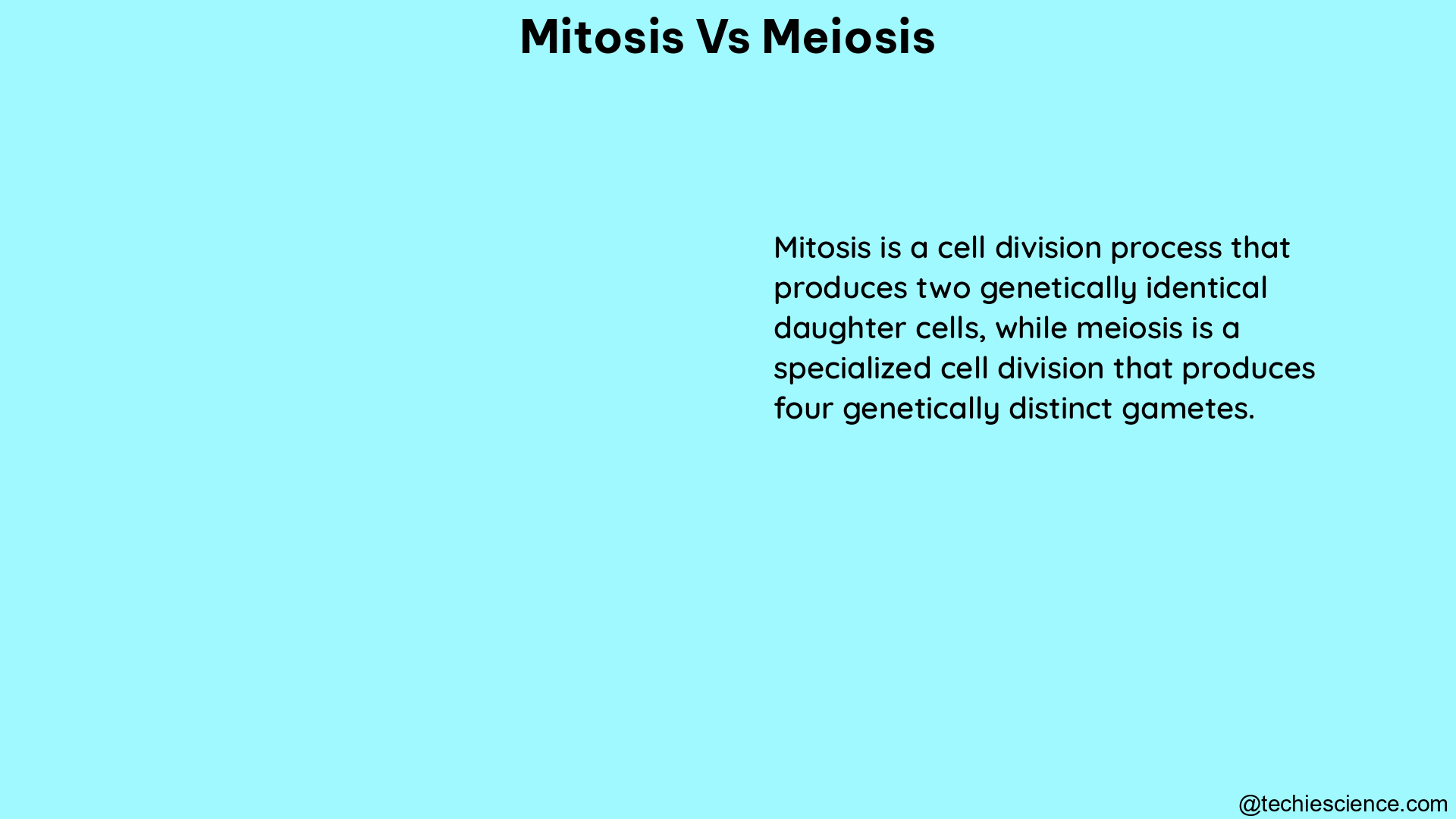Mitosis and meiosis are two fundamental cellular processes that play crucial roles in the growth, development, and reproduction of living organisms. Understanding the intricate differences between these two modes of cell division is essential for comprehending the underlying principles of genetics, cell biology, and evolutionary biology. In this comprehensive blog post, we will delve into the unique features, theorems, examples, figures, and data points that distinguish mitosis from meiosis, providing a valuable resource for biology students and enthusiasts.
The Essence of Mitosis
Mitosis is the process of cell division that results in the formation of two genetically identical daughter cells, each with the same number and type of chromosomes as the parent cell. This process is the primary mechanism by which cells grow, repair, and reproduce in multicellular organisms. The stages of mitosis include prophase, prometaphase, metaphase, anaphase, and telophase, followed by cytokinesis, which divides the cytoplasm of the cell.
Key Features of Mitosis
- Chromosome Number: The daughter cells produced through mitosis are diploid (2n), meaning they have the same number of chromosomes as the parent cell.
- Genetic Composition: The daughter cells are genetically identical to the parent cell and to each other, as there is no genetic recombination during the process.
- Purpose: Mitosis is responsible for the growth, repair, and replacement of somatic (body) cells in multicellular organisms.
- Examples: Mitosis occurs in the cells of the skin, liver, bone, and other tissues to facilitate growth, healing, and maintenance.
The Essence of Meiosis

Meiosis, on the other hand, is a specialized type of cell division that results in the formation of four genetically unique daughter cells, each with half the number of chromosomes as the parent cell. This process is essential for sexual reproduction, as it produces gametes (sperm and egg cells) that can fuse during fertilization to form a zygote with the full complement of chromosomes. The stages of meiosis include prophase I, metaphase I, anaphase I, telophase I, and cytokinesis, followed by prophase II, metaphase II, anaphase II, telophase II, and cytokinesis.
Key Features of Meiosis
- Chromosome Number: The daughter cells produced through meiosis are haploid (n), meaning they have half the number of chromosomes as the parent cell.
- Genetic Composition: The daughter cells are genetically unique due to the process of crossing over, which occurs during prophase I. Crossing over is the exchange of genetic material between homologous chromosomes, resulting in new combinations of genes in the daughter cells.
- Purpose: Meiosis is responsible for the production of gametes (sperm and egg cells) in sexually reproducing organisms, ensuring genetic diversity in the offspring.
- Examples: Meiosis occurs in the gonads (ovaries and testes) of animals and the anthers and ovules of plants to produce gametes for sexual reproduction.
Comparing Mitosis and Meiosis
To further illustrate the differences between mitosis and meiosis, let’s examine the key characteristics in a tabular format:
| Characteristic | Mitosis | Meiosis |
|---|---|---|
| Purpose | Growth and repair of body cells | Production of gametes for sexual reproduction |
| Number of daughter cells | Two | Four |
| Chromosome number in daughter cells | Diploid (2n) | Haploid (n) |
| Genetic variation in daughter cells | None | High |
| Stages | Prophase, prometaphase, metaphase, anaphase, telophase, cytokinesis | Prophase I, metaphase I, anaphase I, telophase I, cytokinesis, prophase II, metaphase II, anaphase II, telophase II, cytokinesis |
| Crossing over | Absent | Present during prophase I |
| Regulation | Controlled by a complex network of signaling pathways that regulate the cell cycle | Regulated by a different set of signaling pathways specific to the germ line |
| Frequency and duration | Continuous process throughout the life of an organism; faster, taking a few hours to complete | Discrete process during gamete production; slower, taking several days or weeks to complete |
| Consequences of errors | Can result in cancer and other diseases | Can result in genetic disorders such as Down syndrome and Klinefelter syndrome |
Visualizing the Differences
To further enhance your understanding of the differences between mitosis and meiosis, let’s examine some illustrative figures:

Figure 1: A comparison of the stages of mitosis and meiosis, highlighting the differences in the number and behavior of chromosomes.

Figure 2: The process of crossing over during meiosis, where homologous chromosomes exchange genetic material, resulting in new combinations of genes in the daughter cells.
These figures provide a visual representation of the key differences between the two cell division processes, making it easier to grasp the underlying concepts.
Conclusion
Mitosis and meiosis are two fundamental processes of cell division that play crucial roles in the life cycle of organisms. While mitosis is responsible for the growth, repair, and reproduction of somatic cells, meiosis is essential for the production of genetically diverse gametes and the maintenance of chromosome number in sexually reproducing organisms. Understanding the intricate differences between these two processes is crucial for comprehending the fundamental principles of genetics, cell biology, and evolutionary biology.
References:
– Mitosis, Meiosis, and Inheritance | Learn Science at Scitable – Nature. (n.d.). Retrieved July 9, 2024, from https://www.nature.com/scitable/topicpage/mitosis-meiosis-and-inheritance-476/
– Salih Gülen, C. (2019). Comparison of Knowledge Levels of Meiosis and Mitosis Divisions in Seventh Graders with Mixed Methods. European Journal of Education Studies, 5(10), 212-225.
– How to Tell the Difference Between Mitosis and Meiosis. (n.d.). Retrieved July 9, 2024, from https://blog.cambridgecoaching.com/how-to-tell-the-difference-between-mitosis-and-meiosis

The lambdageeks.com Core SME Team is a group of experienced subject matter experts from diverse scientific and technical fields including Physics, Chemistry, Technology,Electronics & Electrical Engineering, Automotive, Mechanical Engineering. Our team collaborates to create high-quality, well-researched articles on a wide range of science and technology topics for the lambdageeks.com website.
All Our Senior SME are having more than 7 Years of experience in the respective fields . They are either Working Industry Professionals or assocaited With different Universities. Refer Our Authors Page to get to know About our Core SMEs.